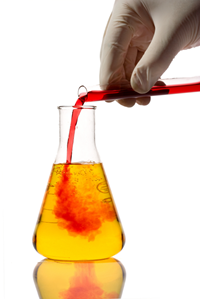Interactions
|
As noted in "Factors Influencing Toxicity," the presence of other chemicals, at the same time, earlier, or later may:
|
Figure 1. Interactions between two or more substances often impact toxicity
(Image Source: iStock Photos, ©) |
Sources of Interactions
Humans are normally exposed to many chemicals at one time. For example, the use of consumer products, medical treatments, and exposures from the diet and environment (such as from soil, air, and water) can consist of exposures to hundreds, if not thousands, of chemicals. Other examples include:
- Hospital patients receive an average of six drugs daily.
- Consumers may use five or more consumer products before breakfast (for example, soap, shampoo, conditioner, toothpaste, and deodorant).
- Home influenza treatment consists of aspirin, antihistamines, and cough syrup taken simultaneously.
- Drinking water may contain small amounts of pesticides, heavy metals, solvents, and other organic chemicals.
- Air often contains mixtures of hundreds of chemicals such as automobile exhaust and cigarette smoke.
- Gasoline vapor at service stations is a mixture of 40-50 chemicals.
Toxicology studies and human health risk assessments have traditionally focused primarily on a single chemical. However, as noted above, people are exposed to many chemicals every day. They are also exposed to non-chemical stressors every day and throughout a lifetime.
In addition, non-chemical stressors include infectious agents, diet, and psychosocial stress, all of which have potential roles in contributing to the health effects associated with chemical exposures.
Approaches for Assessing Interactions
Development of methods to assess the health effects associated with complex exposures is underway at various organizations (EPA, NIEHA).
Non-animal tools and approaches are demonstrating high potential for use in assessing combined effects of chemicals on humans and the environment. These tools and approaches may help uncover information about new mixture components or entire mixtures, which can promote understanding of the underlying mechanisms of their combined effects. The strategies for assessing interactions rely less on in vivo testing and more on non-animal studies and computational tools and incorporate emerging approaches such as:
- The adverse outcome pathway (AOP) concept.
- In vitro methods.
- “Omics” techniques.
- In silico approaches such as quantitative structure activity relationships (QSARs).
- Read-across.
- Toxicokinetic modeling.
- Integrated approaches to testing and assessment (IATA).
The goals include the development of more effective and comprehensive regulatory assessments while reducing the reliance on animal testing.
Figure 4. Modern testing methods rely heavily on computational toxicology
(Image Source: iStock Photos, ©)
(Image Source: iStock Photos, ©)
Knowledge Check (Solutions on next page)
1) The presence of one chemical decreasing toxicity of another chemical is called:
a) Additivity
b) Antagonism
c) Synergism
2) TRUE or FALSE? Additivity is when the combined toxic effects of two chemicals when given together is less than the sum of their individually measured toxic effects.
a) True
b) False
3) TRUE or FALSE? Piperonyl butoxide is not an insecticide; however, it can greatly increase the effects of a pyrethrum insecticide. Thus, piperonyl butoxide can be called a synergist and this interaction can be called synergism.
a) True
b) False
1) The presence of one chemical decreasing toxicity of another chemical is called:
a) Additivity
b) Antagonism
c) Synergism
2) TRUE or FALSE? Additivity is when the combined toxic effects of two chemicals when given together is less than the sum of their individually measured toxic effects.
a) True
b) False
3) TRUE or FALSE? Piperonyl butoxide is not an insecticide; however, it can greatly increase the effects of a pyrethrum insecticide. Thus, piperonyl butoxide can be called a synergist and this interaction can be called synergism.
a) True
b) False





